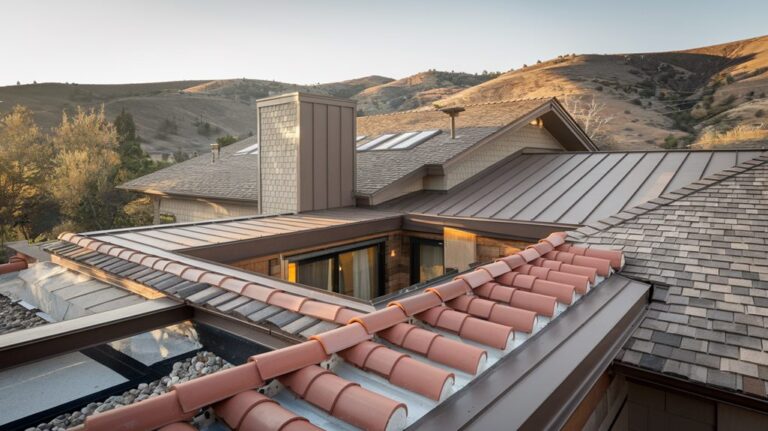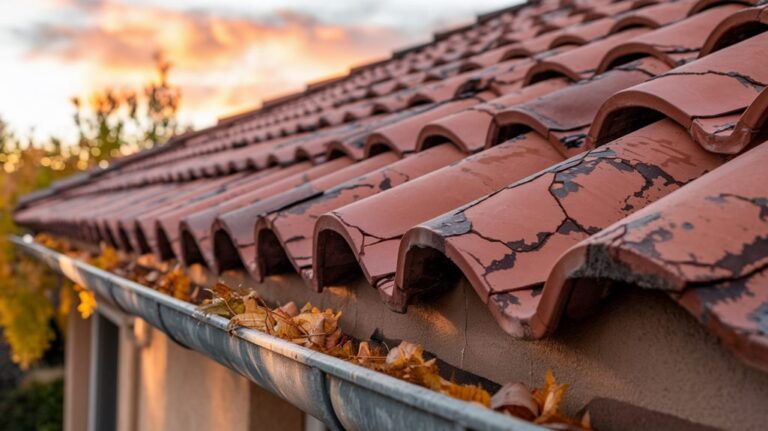Your Walnut Creek roof will show clear warning signs when it needs repairs. Watch for water stains on ceilings, peeling paint, and dark spots that indicate leaks. Check your roof's exterior for missing, cracked, or curled shingles – especially after strong winds. Pay attention to your gutters, as excessive granules from deteriorating asphalt shingles signal aging materials. Don't ignore sagging areas, visible daylight through roof boards, or damaged flashing around chimneys and vents. Early detection and prompt repairs can save you thousands in structural damage. Let's explore the specific red flags that demand immediate attention.
Roof Damage Awareness Guide
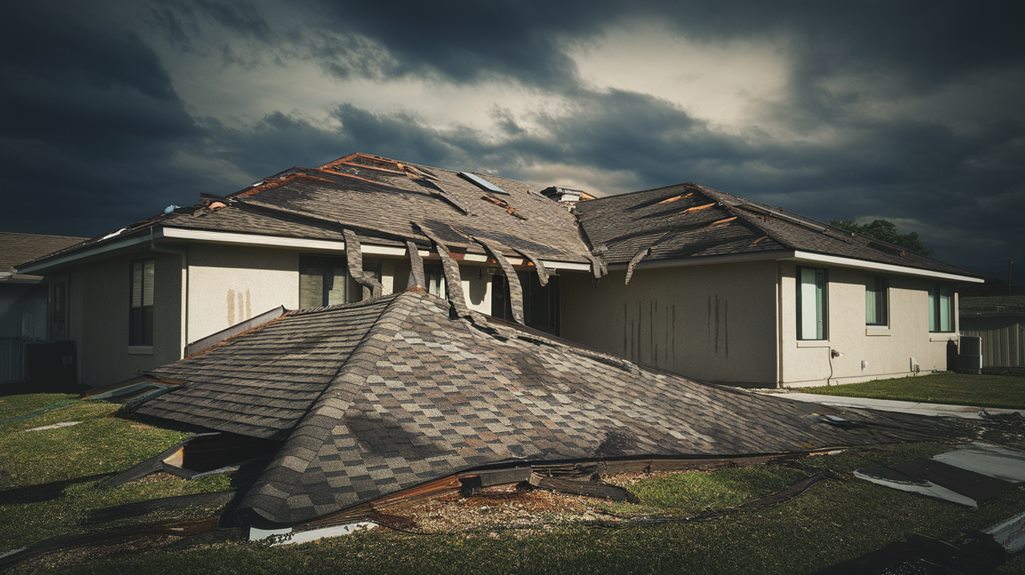
On your Walnut Creek home, roof damage can develop gradually or appear suddenly after severe weather. To protect your investment, you'll need to recognize common warning signs before they lead to costly repairs. Check your ceilings regularly for water stains, peeling paint, or dark spots that indicate moisture penetration. These symptoms often point to compromised roofing materials above.
Inspect your roof's exterior for missing, cracked, or curled shingles, which leave your home vulnerable to water damage. Pay attention to your gutters and downspouts – excessive granules from asphalt shingles signal deterioration. If you notice sagging areas or visible daylight through your roof boards, you're facing structural issues that require immediate attention.
Additionally, examine your attic for proper ventilation. Poor airflow leads to moisture buildup, which can rot wooden supports and encourage mold growth. Watch for damaged flashing around chimneys, vents, and valleys where leaks commonly occur. In Walnut Creek's variable climate, you should also look for wind damage after storms, including loose shingles or debris impact marks. If you spot any of these issues, contact a licensed roofing contractor promptly.
Rainy Season's Roofing Reality Check
When Walnut Creek's rainy period arrives, your roof faces its toughest examination of the year. Heavy rainfall exposes vulnerabilities in your roofing system, uncovering issues you might have overlooked during drier months. Watch for water stains on your ceiling, as they are often the initial sign of a compromised roof.
You'll need to inspect your gutters and downspouts before and throughout the rainy season. Blocked drainage systems can compel water to accumulate on your roof, resulting in material deterioration and potential leaks. Do not disregard small drips or moist areas – they are likely to worsen as the season progresses.
If you observe missing shingles or damaged flashing, deal with these concerns promptly. Water can infiltrate through these weak spots and cause extensive damage to your roof's underlying structure. Pay attention to your attic as well. Musty smells, damp insulation, or visible mold growth indicate moisture issues that necessitate professional attention.
During Walnut Creek's rainy period, your roof's age becomes particularly significant. Older roofs (15+ years) are more vulnerable to water damage and may require more frequent inspections. Consider arranging a professional evaluation before the heaviest rains start to make certain your roof is prepared for the challenges ahead.
Roofing Warning Signs Overview
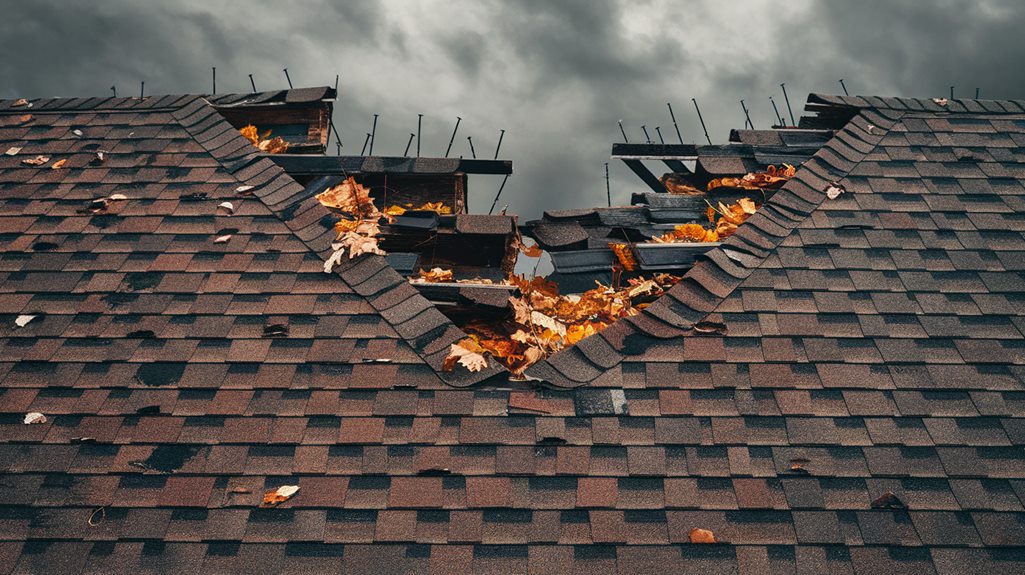
Understanding roofing warning signs goes hand in hand with protecting your home during Walnut Creek's rainy season. You'll need to watch for several key indicators that signal potential roof problems before they escalate into costly repairs.
Look for missing, cracked, or curling shingles, which often result from weather exposure and aging. Check your gutters for excessive granules from deteriorating shingles. If you spot water stains on your ceiling or walls, you're likely dealing with a leak that needs immediate attention. Dark spots, mold growth, or a musty odor in your attic can indicate moisture penetration and poor ventilation.
You should also inspect your roof's flashing around chimneys, vents, and skylights, as damaged or loose metal pieces can lead to water infiltration. Pay attention to sagging areas on your roof deck, as they might signal structural issues or water damage. During your inspection, don't forget to examine the roof valleys, where two roof slopes meet, as these areas are particularly vulnerable to wear and tear. If you notice daylight coming through your roof boards or feel springy spots while walking on your roof, you're dealing with serious structural concerns that require professional assessment.
Aging Roof Safety Concerns
Living beneath an aging roof in Walnut Creek poses significant safety risks for homeowners. As your roof deteriorates, you'll face increased chances of structural collapse, especially during California's wet winters and occasional severe storms. Weakened support beams, rotting decking, and compromised trusses can give way without warning, putting your family in danger.
Your aging roof can also create serious health hazards. When water penetrates old shingles and underlayment, it often leads to toxic mold growth in your attic and walls. Poor ventilation in aging roofs compounds this problem, trapping moisture and creating ideal conditions for harmful spores to thrive. Additionally, damaged roofing materials can release asbestos fibers if your home was constructed before the 1980s.
You'll also need to take into account how an aging roof affects your home's electrical system. Water infiltration near wiring can cause short circuits, creating fire hazards throughout your house. If you notice sagging areas, water stains, or musty odors, don't hesitate to call a professional. These warning signs indicate your roof's deterioration has reached a critical point requiring immediate attention.
Prevent Costly Structural Damage

Proactive maintenance of your Walnut Creek roof can save you thousands in structural repairs down the line. When you ignore minor roofing issues, they often escalate into major structural problems that affect your home's foundation, walls, and ceiling joists. Water intrusion through damaged shingles can rot wooden supports, weaken load-bearing elements, and compromise your home's integrity.
You'll want to address these warning signs immediately: sagging sections in your roof, cracked or missing shingles, and water stains on your ceiling. If you notice your energy bills climbing unexpectedly, it could indicate compromised insulation from water damage. Don't overlook mold growth, as it's often a sign of hidden moisture problems that can deteriorate your roof's structure.
Schedule professional inspections twice a year, especially before and after Walnut Creek's rainy season. Your inspector should check for proper ventilation, examine flashing around chimneys and vents, and assess the condition of your gutters. They'll also look for signs of pest infestation, which can accelerate structural deterioration. By catching and fixing minor issues early, you'll protect your home's structural integrity and avoid the hefty cost of major repairs.
Mediterranean Climate Impacts Roofing
Walnut Creek's Mediterranean climate, with its up and down temperature swings, imposes unique stress on residential roofing systems. You'll notice these temperature fluctuations can cause your roofing materials to expand and contract repeatedly, potentially leading to cracked shingles, loosened flashing, and compromised seals around vents and chimneys.
During summer months, when temperatures soar above 90°F, your roof absorbs intense UV radiation that can accelerate shingle aging and cause premature deterioration. The heat can also warp wooden support structures and damage underlayment materials. In winter, while Walnut Creek doesn't typically see snow, you'll experience heavy rains that test your roof's water resistance and drainage systems.
The region's seasonal pattern of wet winters and dry summers creates additional challenges. You'll need to watch for moss and algae growth during humid periods, which can compromise your roof's integrity. During the dry season, your roofing materials may become brittle and more susceptible to damage. It's crucial to schedule regular inspections before each major seasonal change to identify potential issues caused by these climate-specific stressors.
Hot Dry Summers, Mild Winters
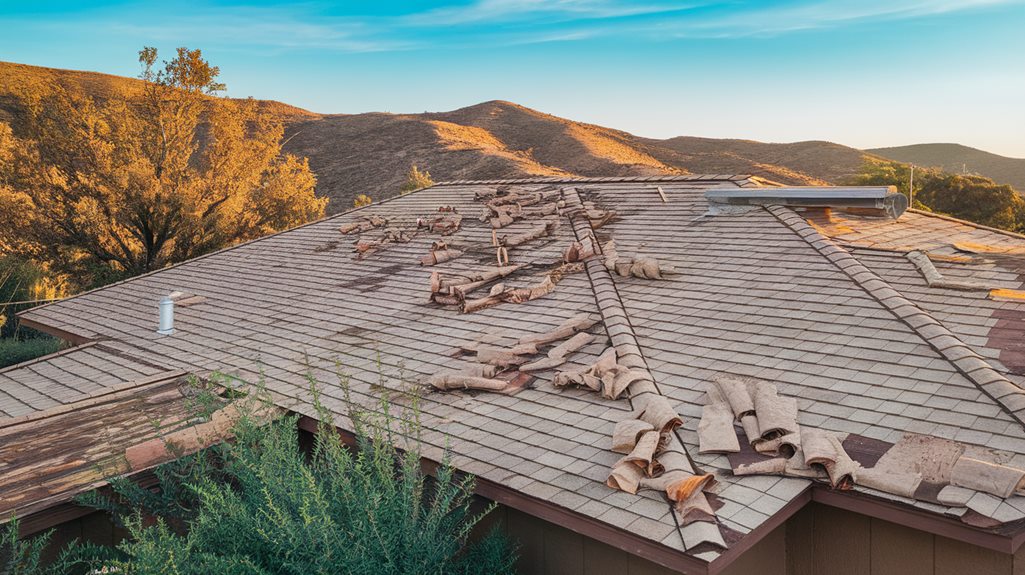
Typically, Walnut Creek's homeowners face distinct roofing challenges during the region's intensely hot, dry summers when temperatures regularly surpass 90°F and the mild winters that bring sporadic rain. Your roof's materials expand during these scorching days and contract during cooler evenings, creating strain on shingles, flashing, and sealants.
During summer months, you'll observe your roofing materials might become brittle from UV exposure and heat damage. This can lead to cracking, warping, or curling of shingles. The extreme heat can also cause your roof's protective oils to evaporate faster, reducing its lifespan. You'll want to check for signs of thermal splitting, especially in older roofing materials.
In winter, while Walnut Creek doesn't experience severe weather, the occasional rainfall can expose vulnerabilities in your roof's structure. You'll need to watch for water stains on your ceiling, which often appear after winter rains. The shift between seasons can also cause problems as temperature fluctuations stress your roofing materials. It's wise to inspect your roof before summer heat arrives and again before winter rains begin to catch potential issues early.
Mission Revival and Spanish Colonial
Featuring distinctive terracotta tiles and curved architectural elements, Mission Revival and Spanish Colonial homes dominate Walnut Creek's upscale neighborhoods. These iconic roofing styles require specialized maintenance to preserve their authenticity and structural integrity. You'll need to inspect your clay tiles regularly for cracks, chips, or displacement that can lead to water intrusion.
Your Mission Revival or Spanish Colonial roof's most vulnerable areas include the curved sections and valleys where tiles meet. If you notice missing or broken tiles, don't wait to replace them, as even small gaps can compromise your entire roofing system. Look for signs of water staining on your interior ceilings, particularly after rain, as this indicates damaged or improperly sealed tiles.
The mortar that secures your ridge tiles can deteriorate over time, requiring repointing to prevent leaks. You'll also want to check the flashing around chimneys and vents, as these areas are prone to separation in Mediterranean-style roofs. If you're hearing scratching sounds or notice displaced tiles, you might have animals nesting under the curved sections, which requires immediate attention to prevent further damage.
Title 24 Roofing Standards
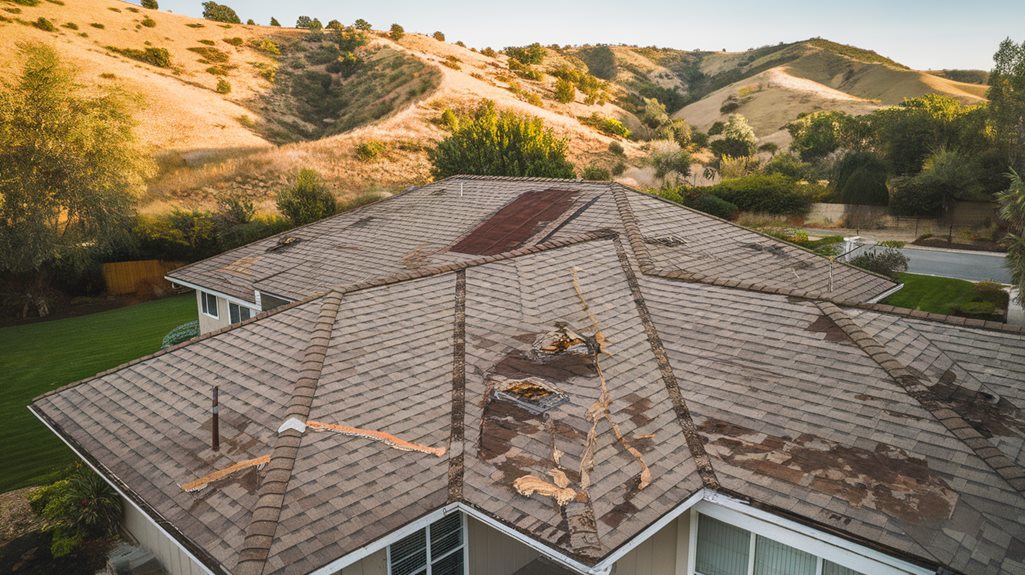
Beyond the aesthetic needs of Mediterranean-style roofs, California's Title 24 Building Energy Efficiency Standards establish specific requirements for roofing materials in Walnut Creek. You'll need to verify that your roof meets these standards when making repairs or replacements, especially concerning solar reflectance and thermal emittance values.
Your roofing materials must achieve a minimum Solar Reflectance Index (SRI) of 16 for steep-sloped roofs and 64 for low-sloped roofs. You can confirm these values through the Cool Roof Rating Council's product directory. When you're planning repairs, you'll want to choose materials that not only complement your home's style but also adhere to these energy efficiency requirements.
The standards also influence your ventilation choices. You'll need appropriate attic ventilation to uphold energy efficiency and prevent heat buildup. If you're replacing more than 50% of your roof, you must bring the entire roof system up to current Title 24 standards. This includes installing cool roof materials, adequate insulation levels, and radiant barriers in some instances. Remember that while these standards may appear strict, they will help lower your energy expenses and enhance your home's comfort level.
Identifying Vulnerable Roofing Areas
Regular inspections of your Walnut Creek roof should focus on several key vulnerable areas where damage commonly occurs. Start by examining your roof's valleys, where two slopes meet and create natural water channels. These areas often experience heavy water flow and are prone to wear and deterioration.
Check your chimney's flashing and the areas around other roof penetrations, including vents, skylights, and satellite dish mounts. These junction points frequently develop leaks if the sealing materials have degraded. You'll also want to inspect the edges of your roof, particularly the fascia boards and soffits, which can rot from water exposure or become damaged by pests.
In Walnut Creek's climate, you should pay special attention to areas where tree branches overhang your roof. These can scratch shingles and deposit debris that traps moisture. Don't forget to examine your roof's ridge line, as it's exposed to strong winds and can develop cracks or missing shingles. Finally, check your gutters and downspouts – clogged drainage systems can cause water to back up under shingles and create hidden damage to your roof's structure.
Common Local Roofing Types
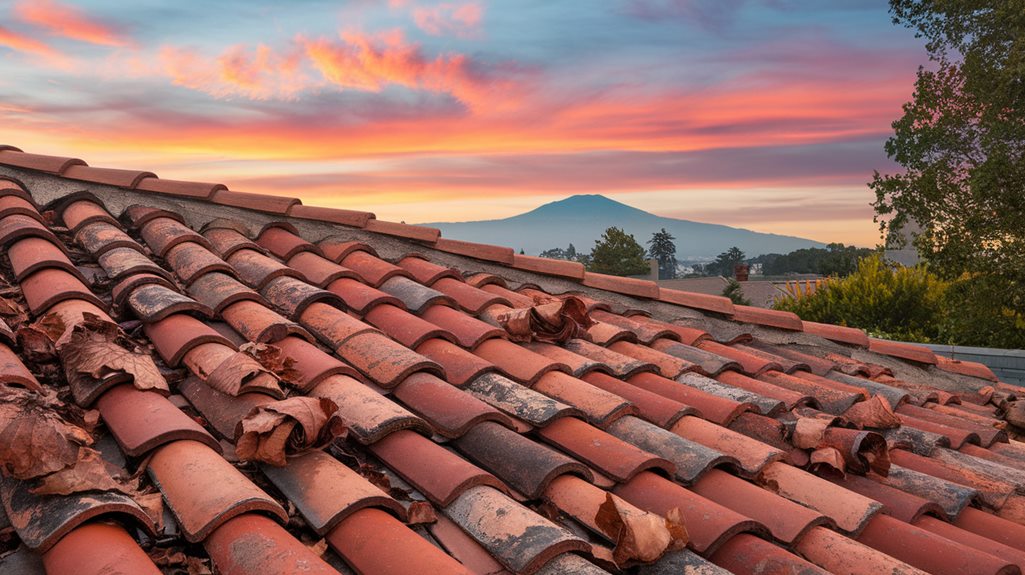
Throughout Walnut Creek, residential roofs typically showcase three predominant materials: asphalt shingles, clay tiles, and slate. Asphalt shingles dominate the local market due to their affordability, durability, and easy installation process. You'll find them on roughly 70% of homes in the area, particularly in neighborhoods built after 1960.
Clay tiles, with their distinctive Mediterranean appearance, are common in Walnut Creek's upscale communities and historic districts. They're excellent for our climate, offering superior protection against sun damage and maintaining consistent indoor temperatures. While they're more expensive, they can last up to 50 years with proper maintenance.
Slate roofs, though less common, appear on many high-end properties and heritage homes throughout the area. You'll recognize them by their natural stone appearance and unique texture. Despite their higher cost, slate roofs can last over 100 years and provide exceptional resistance to fire and extreme weather conditions. They're particularly valuable in Walnut Creek's fire-prone regions, where homeowners prioritize safety features. Each of these materials requires specific maintenance approaches and repair techniques, which professional roofers in the area are well-versed in handling.
Composite Shingle Roofing
Homeowners in Walnut Creek increasingly choose composite shingles as a modern alternative to traditional asphalt materials. These engineered shingles combine fiberglass, recycled paper products, and asphalt to create a durable, weather-resistant roofing solution that's perfect for the area's Mediterranean climate.
You'll find that composite shingles offer significant advantages over conventional materials. They're designed to withstand UV rays, heavy rains, and wind speeds up to 130 mph. Most manufacturers provide warranties ranging from 30 to 50 years, making them a cost-effective long-term investment for your home.
When examining your composite shingle roof for damage, look for signs of granule loss, curling edges, or missing shingles. You might notice dark streaks, which often indicate algae growth, or bald spots where the protective granules have worn away. If you spot cracked or broken shingles, don't wait to address the issue – these problems can quickly lead to leaks and structural damage.
Regular maintenance of your composite shingle roof includes clearing debris, checking for loose or damaged shingles, and ensuring proper attic ventilation. You'll extend your roof's lifespan by addressing minor repairs promptly and scheduling professional inspections annually.
Optimal Lifespan in Coastal Conditions
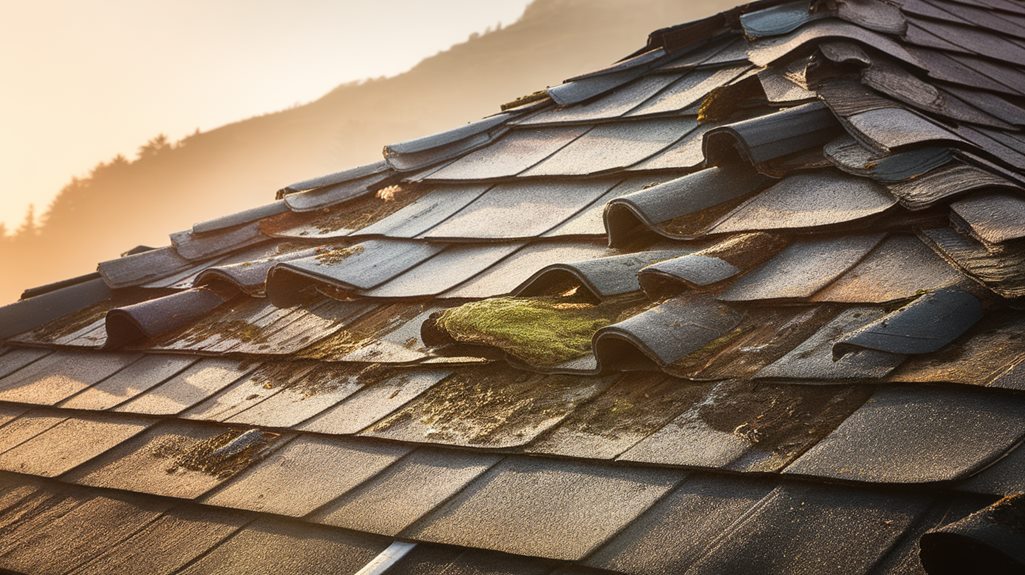
While composite shingles offer excellent durability, coastal conditions present unique challenges for roofing materials in Walnut Creek. You'll notice that sea air, moisture, and variable temperatures can impact your roof's performance and longevity. In typical inland conditions, composite shingles last 20-30 years, but coastal environments can reduce this lifespan by 20-30%.
To maximize your roof’s longevity in Walnut Creek’s coastal climate, you’ll need to implement specific maintenance strategies. Start by scheduling bi-annual inspections to check for salt deposits, algae growth, and moisture accumulation. Don’t forget to clean your gutters every three months, as salt-laden debris can accelerate shingle deterioration. Additionally, ensure that any damaged shingles are replaced promptly to prevent leaks and further damage to your home. Investing in a quality roof coating can also offer extra protection against the harsh coastal elements. This highlights the importance of regular roof maintenance, as it not only extends the life of your roof but also safeguards your home’s overall integrity.
You can extend your roof's best possible lifespan by choosing algae-resistant shingles and ensuring proper ventilation. Install zinc or copper strips near the ridge to prevent algae growth, and maintain adequate attic airflow to minimize moisture buildup. If you're within five miles of the coast, consider upgrading to impact-resistant shingles rated for high-wind zones. Remember, proactive maintenance and appropriate material selection will help your composite shingle roof reach its full potential in Walnut Creek's coastal environment.
Durability Against Bay Winds
Bay breezes pose substantial challenges for Walnut Creek roofs, with gusts regularly reaching 30-40 mph during storm seasons. These powerful winds can lift shingles, create pressure points, and gradually weaken your roof's structural integrity. You'll notice the impact particularly on the windward side of your home, where shingles face the strongest force from the Bay Area's weather patterns.
To protect against wind damage, you'll need properly installed flashing, reinforced edges, and correctly spaced fasteners. Your roof's durability depends heavily on the quality of its initial installation and the materials used. Six nails per shingle, rather than the standard four, can notably increase wind resistance in high-pressure zones.
You should inspect your roof after major wind events, looking for telltale signs of damage: loose or missing shingles, lifted edges, and debris accumulation in valleys. Wind-driven rain can exploit even minor vulnerabilities, so don't overlook small issues. If you spot granules collecting in your gutters or notice shingles starting to curl, it's time to call a professional. Regular maintenance and timely repairs will ensure your roof maintains its defensive capabilities against Bay Area wind conditions.
Average -7 per Sq.Ft
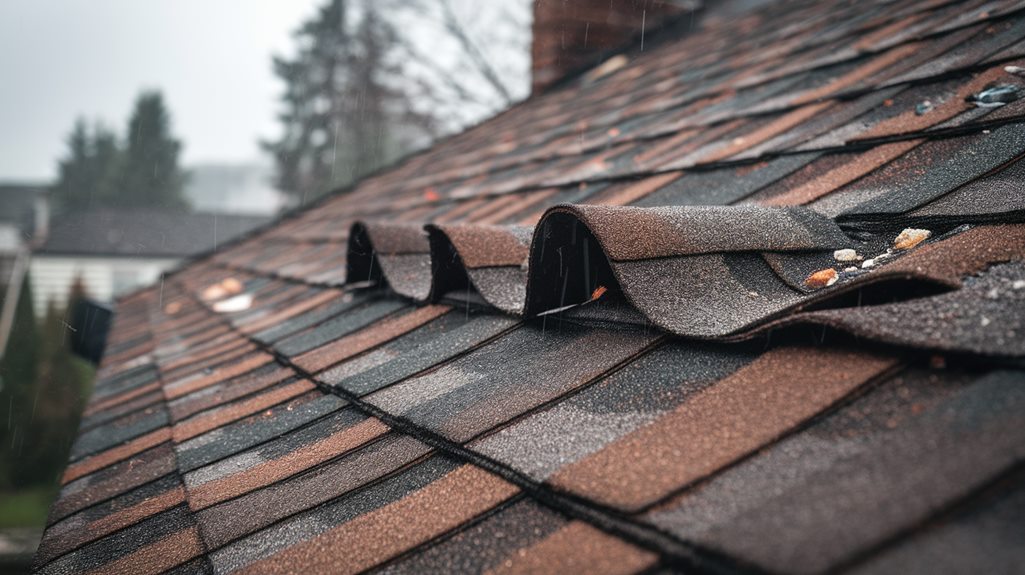
Protecting your roof against wind damage comes with specific costs in the Walnut Creek area. You'll find that most local contractors charge between $5-7 per square foot for basic wind damage repairs, which includes securing loose shingles, replacing damaged flashing, and reinforcing weak spots in your roofing structure.
For a typical 2,000-square-foot Walnut Creek home, you're looking at repair costs ranging from $10,000 to $14,000 if your entire roof needs attention. However, most wind damage repairs are localized, so you'll likely pay for only the affected areas. Partial repairs might cost $500-$1,500 for a 100-200 square foot section.
You'll want to factor in additional costs that can affect the final price. These include:
- Premium materials resistant to Bay Area winds ($1-2 extra per sq.ft)
- Removal of existing damaged materials ($2-3 per sq.ft)
- Permits and inspections ($200-500)
- Labor rates during peak season (15-20% higher)
Don't forget that your homeowner's insurance might cover wind damage repairs, especially if they're due to severe weather events. You'll need to document the damage thoroughly and contact your insurance provider promptly.
Clay Tile Performance
Traditional clay tiles consistently outperform other roofing materials in Walnut Creek's diverse climate conditions. When properly maintained, clay tile roofs can last up to 100 years, making them one of the most durable roofing options you'll find. Their natural composition and thermal properties help regulate your home's temperature, reducing energy costs throughout the year.
If you're considering clay tiles for your Walnut Creek home, you'll benefit from these performance advantages:
- Superior fire resistance – Clay tiles won't burn or melt, providing excellent protection during California's fire season
- Wind resistance up to 150 mph – They're less likely to lift or detach during strong winter storms
- Impact resistance – Clay tiles hold up well against hail and falling branches, though they can crack if struck directly
- Low maintenance requirements – They don't rot, warp, or attract insects like other materials
While clay tiles cost more initially, their longevity and performance make them cost-effective over time. You'll need professional installation to [guarantee] proper weight distribution and prevent structural issues, as clay tiles are heavier than conventional roofing materials.
0-Year Tile Life Expectancy
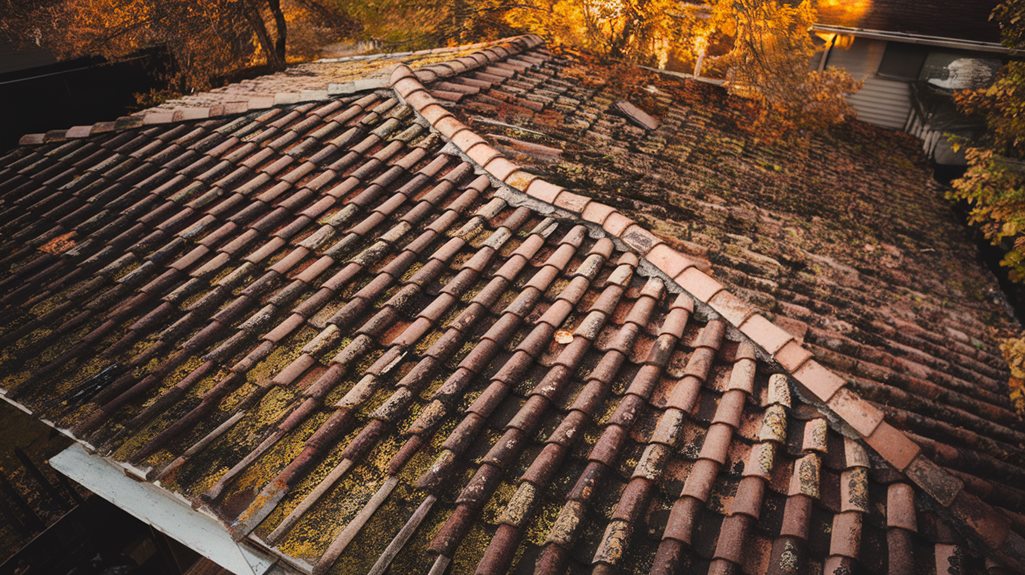
Building on clay tiles' exceptional durability, let's examine the specific life spans you can anticipate from different tile types in Walnut Creek. With proper installation and maintenance, concrete tiles typically last 50-75 years, while premium clay tiles can endure for 75-100 years or more. Your tile roof's longevity largely depends on local weather conditions and maintenance practices.
In Walnut Creek's moderate climate, you'll find that properly installed tiles often exceed their estimated lifespan. Traditional Spanish tiles, when maintained correctly, can protect your home for up to a century. Modern concrete tiles, though slightly less durable, still offer impressive 50-year warranties from most manufacturers. You'll need to take into account that slate tiles can last even longer, often surviving 100-150 years with minimal maintenance.
Don't forget that environmental factors affect tile longevity. Walnut Creek's occasional high winds, rare freezing temperatures, and summer heat can impact your tiles' lifespan. You'll maximize your roof's durability by scheduling regular inspections, promptly replacing cracked tiles, and maintaining clean gutters. Remember that while tiles may last decades, underlying materials like underlayment typically need replacement every 20-30 years.
Limited Color Selection Available
Today's homeowners may feel constrained by the limited color palette available for tile roofs in Walnut Creek. While manufacturers have expanded their offerings in recent years, you'll still find that most local suppliers stock only traditional earth-tone selections. This limitation stems from both practical perspectives and local architectural guidelines that aim to maintain the area's aesthetic harmony.
When you're choosing your tile roof color in Walnut Creek, you'll typically encounter these standard options:
- Terra cotta reds and oranges, which reflect the region's Spanish Colonial influence and remain the most popular choice
- Warm browns and tans that complement Mediterranean-style homes and blend well with natural surroundings
- Slate grays and charcoals that offer a more contemporary look while meeting HOA requirements
- Mixed-tone blends that combine two or three compatible colors for added visual interest
If you're seeking more unique colors, you'll need to explore special ordering, which can increase both cost and installation time. However, these traditional color options have proven their longevity and resale value in the Walnut Creek market, making them a practical choice for most homeowners.
Average Labor Cost /Day
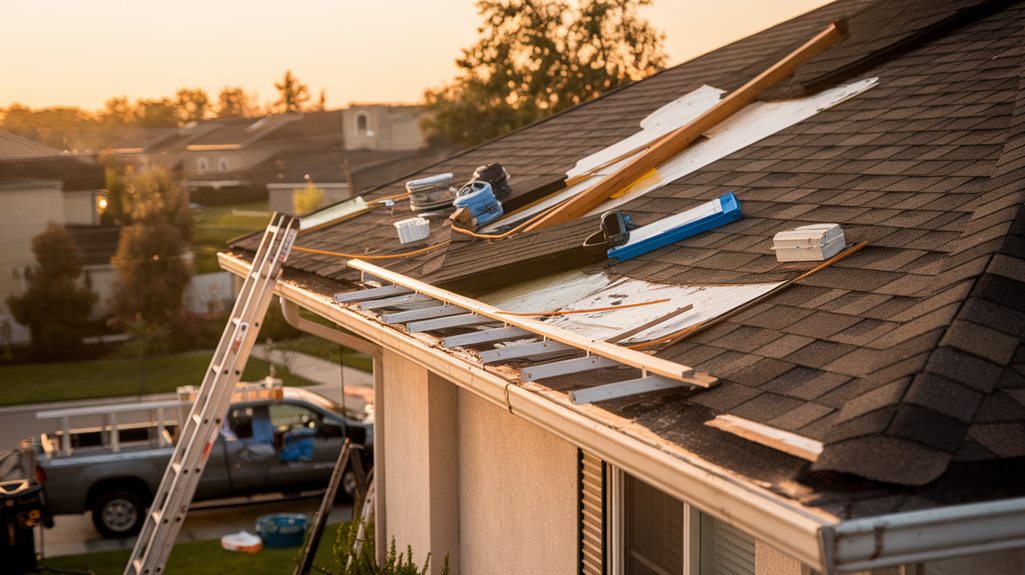
Beyond the aesthetic considerations of roof tile colors, labor costs represent a significant portion of your roofing budget in Walnut Creek. You'll need to budget approximately $750 per day for skilled roofing labor, which typically includes a crew of 3-4 experienced professionals. This rate reflects the high cost of living in the Bay Area and the specialized skills required for quality roof repairs.
Your total labor costs will depend on the scope of repairs needed. Small fixes, like replacing a few damaged shingles or patching a minor leak, might only require one day of work. However, more extensive damage could require multiple days, potentially pushing your labor costs into the $2,000-$3,000 range. Don't forget that this daily rate doesn't include materials, permits, or disposal fees.
To maximize the value of your labor costs, you'll want to bundle multiple repairs together when possible. Many Walnut Creek contractors offer slight discounts on the daily rate for larger projects, and you'll save money by addressing all your roofing issues at once rather than paying multiple minimum charges for separate visits.
Critical Roof Warning Signs
Homeowners in Walnut Creek must learn to recognize several warning signs that indicate potential roof damage before it becomes critical. Your roof's condition directly impacts your home's structural integrity and your family's safety, so it's important to identify problems early.
Watch for these significant warning signs that suggest you need professional roof repairs:
- Water stains on your ceiling or walls, especially after rain, indicate active leaks that can lead to mold growth and structural damage if left unattended
- Missing, cracked, or curling shingles, which often result from Walnut Creek's intense summer heat and winter storms, leaving your roof susceptible to water infiltration
- Granules collecting in gutters or at downspout exits, signaling that your asphalt shingles are deteriorating and losing their protective layer
- Visible sagging or dips in your roofline, which may indicate serious structural issues with roof decking or supporting rafters
Don't wait until you're dealing with major leaks or extensive damage. If you notice any of these signs, contact a licensed Walnut Creek roofing contractor immediately for a thorough inspection and necessary repairs.
Missing Shingles After Storms
Storm damage assessment reveals that missing shingles are one of the most common roofing problems Walnut Creek residents face after severe weather events. If you've noticed shingles scattered across your yard after a storm, don't wait to address the issue. Missing shingles leave your roof vulnerable to water infiltration, which can lead to extensive structural damage.
You'll need to inspect your roof carefully after each major storm, looking for dark patches or areas where the underlying roofing material is exposed. These bare spots indicate where shingles have been torn away by high winds. Pay special attention to the edges and corners of your roof, as these areas are particularly prone to wind damage.
When you spot missing shingles, it's essential to document the damage with photos and contact a licensed Walnut Creek roofing contractor immediately. They'll assess whether individual shingle replacement is sufficient or if more extensive repairs are needed. Remember that your homeowner's insurance may cover storm-related shingle damage, so keep detailed records of the weather event and resulting damage. Quick action will prevent water from seeping beneath remaining shingles and compromising your roof's integrity.
Wind-Driven Winter Rainstorms
Powerful winter rainstorms in Walnut Creek can pummel your roof with wind-driven rain that tests even the most robust shingles and flashing. When rain hits your roof at sharp angles due to high winds, it can force water beneath your shingles and create leaks in places you wouldn't expect. These storms often expose vulnerabilities in your roof's weather barrier that might go unnoticed during calmer conditions.
You'll want to pay special attention to these critical areas during and after wind-driven rainstorms:
- Valley intersections where two roof slopes meet, as these collect concentrated water flow
- Flashing around chimneys and vents, which can loosen or tear away in strong winds
- Eave edges and overhangs, where wind can lift shingles and drive rain underneath
- Ridge caps at the peak of your roof, which take the brunt of wind forces
Don't wait until you notice water stains on your ceiling. After each major storm, it's smart to inspect your attic for signs of water intrusion and check your yard for displaced shingles. Early detection of storm damage can prevent costly interior repairs down the road.
Apply Weatherproof Sealant Strips
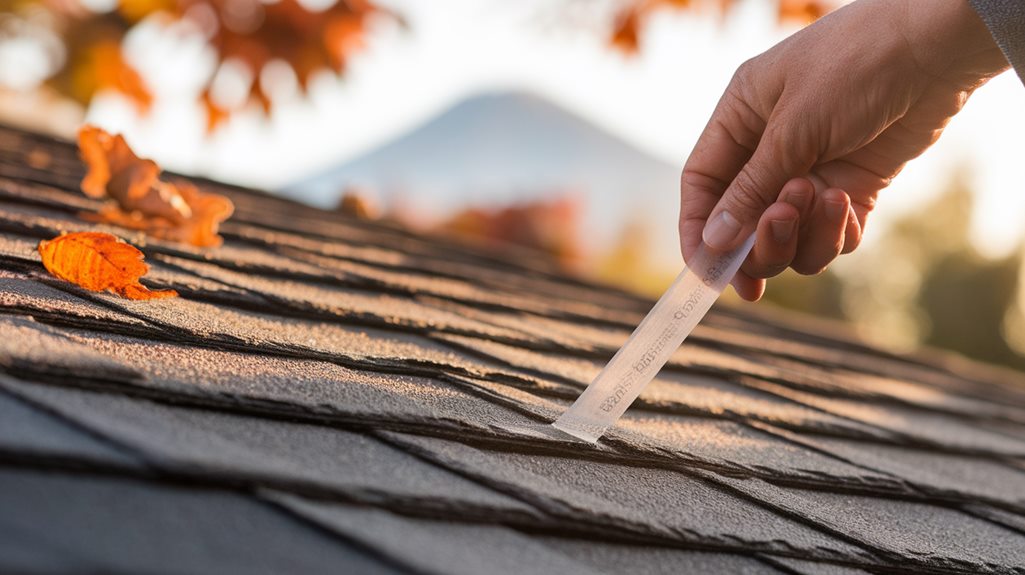
Along vulnerable roof edges and joints, weatherproof sealant strips provide an important defense against water infiltration and wind uplift. You'll need to carefully inspect your roof's flashings, valleys, and ridges to identify areas that require additional waterproofing protection. These self-adhesive strips create a reliable barrier that prevents moisture from seeping underneath your roofing materials.
To apply the sealant strips effectively, you'll want to make sure the surface is clean, dry, and free of debris. Start by measuring and cutting the strips to fit your specific application areas. Remove the backing paper and press the strips firmly into place, working from the center outward to prevent air bubbles. It's vital to overlap the strips by at least 2 inches when covering longer sections.
For maximum effectiveness, you should apply these strips during warm, dry weather conditions when temperatures are above 50°F. Focus on areas around chimneys, skylights, and vent pipes where leaks commonly occur. You'll also want to seal any gaps around nail heads or damaged shingles. Remember to inspect these weatherproof strips annually and replace them if you notice any signs of deterioration or separation.
Cracked Flashing Near Chimneys
Cracked flashing around chimneys often leads to some of the most persistent roof leaks in Walnut Creek homes. You'll typically notice these issues during our Bay Area rainy season when water starts seeping into your ceiling or walls near the chimney area. Metal flashing serves as your roof's critical defense system, creating a watertight seal where your chimney meets the roofing materials.
When you're inspecting your chimney's flashing, look for these telling signs of damage:
- Rust spots or corrosion on the metal flashing surfaces
- Gaps between the flashing and chimney brick
- Bent or pulled-away sections of step flashing
- Cracked or missing caulk at sealing points
Don't wait to address flashing problems, as they'll only worsen with time and exposure to Walnut Creek's varying weather conditions. If you spot any of these issues, you'll need to either reseal the flashing or replace it entirely. While minor repairs might involve applying new sealant, significant cracks or corrosion typically require professional replacement to [GUARANTEE] proper water protection for your roof system.
Sudden Temperature Fluctuation Damage
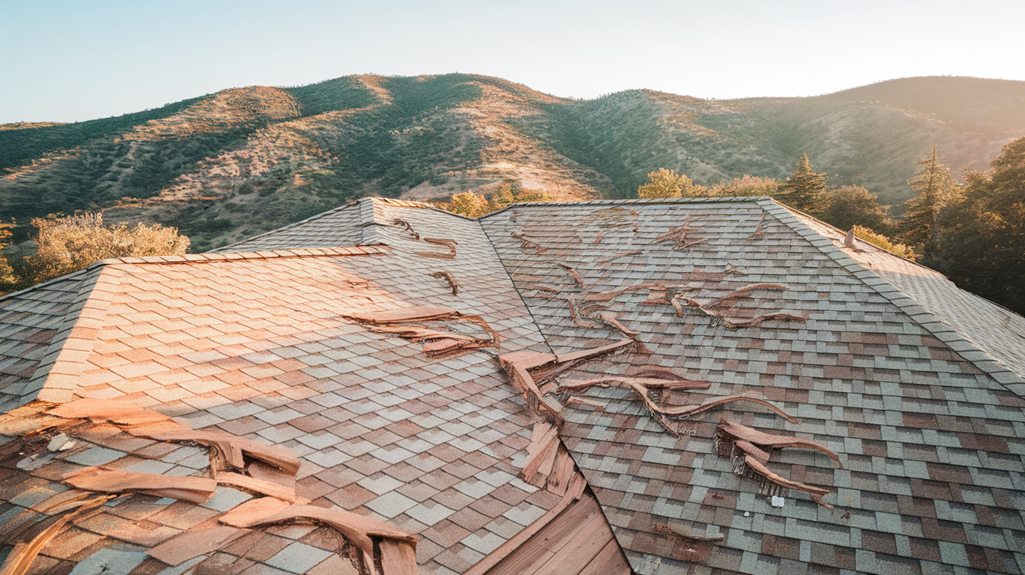
Temperature fluctuations in Walnut Creek can wreak havoc on your roof's structural stability. When your roofing materials repeatedly expand in the heat and contract in the cold, they'll develop stress points that can lead to serious damage. These thermal cycles particularly affect metal components like flashing and fasteners, which expand and contract at different rates than surrounding materials.
You'll notice signs of temperature variation damage in several ways. Your shingles might start curling at the edges, or you'll spot cracks developing along stress points. The constant expansion and contraction can also loosen nails and create gaps between roofing materials. In Walnut Creek's climate, where temperatures can shift from cool mornings to hot afternoons, these issues become more pronounced during seasonal alterations.
To safeguard your roof, you'll want to guarantee proper attic ventilation to minimize temperature extremes. Check your roof regularly for signs of material fatigue, especially after significant temperature changes. If you spot warped shingles, separated seams, or loose fasteners, don't wait to address these issues. Professional roofers can install temperature-resistant materials and implement proper expansion joints to help your roof better withstand Walnut Creek's temperature variations.
Apply Waterproof Membrane Underlayment
Before installing new roofing materials, applying a waterproof membrane underlayment provides vital protection for your Walnut Creek home. This essential barrier helps prevent water damage, extends your roof's lifespan, and offers an additional defense against Walnut Creek's occasional heavy rains and moisture intrusion.
You'll want to make sure your contractor installs the membrane correctly, paying special attention to vulnerable areas like valleys, chimneys, and skylights. Modern synthetic underlayments offer superior protection compared to traditional felt paper, creating a more reliable moisture barrier for your home.
- The membrane should extend at least 24 inches past your home's exterior walls to prevent water from seeping into your foundation
- All seams need to overlap by at least 6 inches to maintain a continuous waterproof barrier
- The material must be secured with appropriate fasteners specifically designed for roof underlayment
- Your contractor should install extra layers around penetrations and in valleys where water tends to collect
Don't skip this essential step in your roof repair process. A properly installed waterproof membrane underlayment can save you thousands in potential water damage repairs and provide peace of mind during severe weather conditions.
Metal Flashings and Gutters
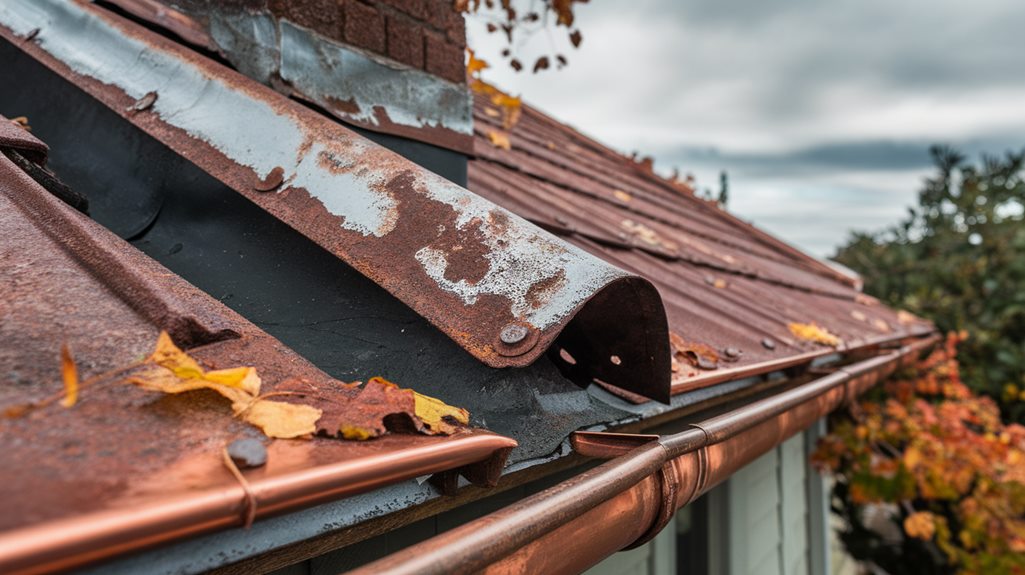
Following proper underlayment installation, your Walnut Creek home needs properly installed metal flashings and reliable gutters to complete its water defense system. Metal flashings protect vulnerable areas where roof planes meet walls, chimneys, and valleys, while gutters channel water away from your home's foundation.
You'll need to inspect your flashings regularly for signs of rust, separation, or damaged sealant. Pay special attention to step flashings along walls, chimney flashings, and valley flashings where two roof slopes meet. If you notice any gaps or rust spots, don't delay to address them – even small flashing issues can lead to serious leaks.
Your gutter system requires equal attention. Check for proper slope, secure fasteners, and clear pathways for water flow. In Walnut Creek's climate, you'll want to verify that your gutters can handle heavy winter rains. Look for signs of sagging, pulling away from the fascia, or overflowing during storms. Make certain downspouts direct water at least five feet away from your foundation and consider installing gutter guards to prevent debris buildup. Replace any sections showing significant wear or damage to maintain your roof's water management system.
Licensed Experts Ensure Protection
When tackling roof repairs in Walnut Creek, you'll want to work with licensed roofing contractors who understand local building codes and safety requirements. These professionals carry proper insurance coverage and maintain their certifications to safeguard your property throughout the repair process. They'll also secure necessary permits and conduct thorough inspections before and after completing any work.
A licensed roofing expert will protect your interests in several critical ways:
- They'll provide detailed written contracts specifying materials, labor costs, project timeline, and warranty information, ensuring transparency and responsibility
- They're well-versed in Contra Costa County's specific climate challenges and can recommend appropriate roofing solutions that endure local weather patterns
- They'll guarantee all work meets California building codes and passes municipal inspections, helping you avoid costly penalties or repairs down the line
- They carry worker's compensation and liability insurance, shielding you from potential lawsuits if accidents occur during repairs
Don't risk working with unlicensed contractors who might cut corners or disappear after collecting payment. Licensed experts not only guarantee quality workmanship but also provide peace of mind through proper documentation and responsibility.
Check State License History
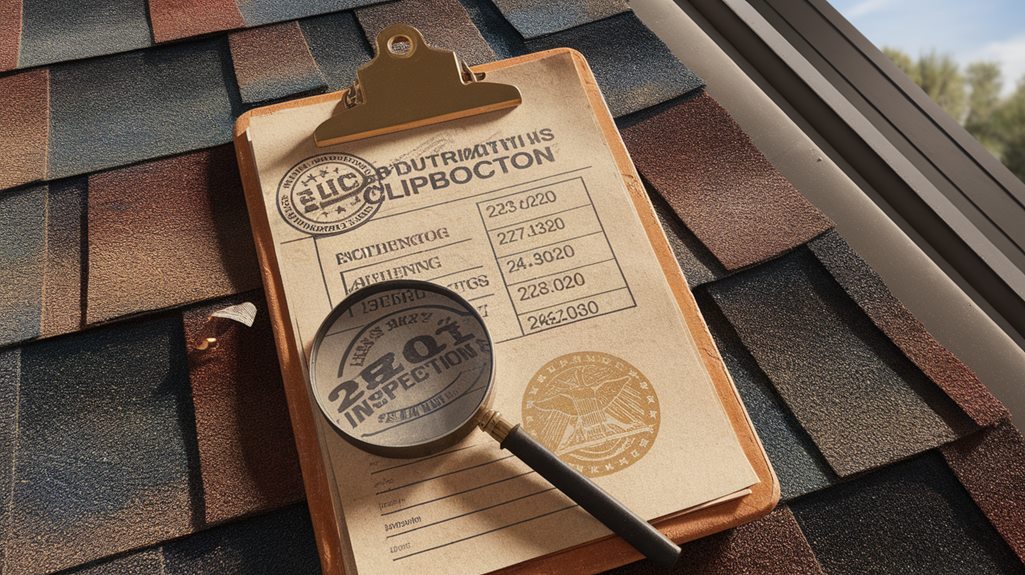
A contractor's license status tells an important story about their reliability and professional conduct. You'll want to verify any Walnut Creek roofing contractor's license through California's Contractors State License Board (CSLB) website before hiring them. The license lookup tool reveals essential information about their business practices and qualifications.
When you check a contractor's license history, you'll discover if they've faced any disciplinary actions, complaints, or suspensions. Pay close attention to their bond status, workers' compensation insurance, and how long they've been licensed. If you spot multiple complaints or unresolved issues, that's a red flag to explore other contractors.
Don't forget to verify that their license classification matches roofing work (C-39 for California). You should also confirm that the license is current and active, as expired or suspended licenses indicate significant problems. If a contractor can't provide their license number or hesitates when you ask for it, that's another warning sign. Remember, state law requires contractors to display their license number on all advertising materials, vehicles, and contracts.
Contra Costa License Board
Local roofing contractors in Walnut Creek must also comply with Contra Costa County's licensing requirements. The Contra Costa County License Board works alongside the California State License Board to guarantee contractors meet local standards and regulations. You'll need to verify that your chosen roofing contractor has both state and county-level approvals before signing any contracts.
To check a contractor's Contra Costa County license status, you can:
- Visit the County's official website and access their contractor verification portal
- Call the Contra Costa License Board directly at their Martinez office
- Request proof of current county licensing from the contractor
- Cross-reference their county license number with state records
The county board maintains strict oversight of construction and repair work throughout Walnut Creek and neighboring communities. They'll help you verify if there are any outstanding complaints, violations, or disciplinary actions against your potential contractor. Keep in mind that legitimate contractors won't hesitate to provide their county license information, and they should display their license numbers on all business materials and contracts.
License Validation Since 2010
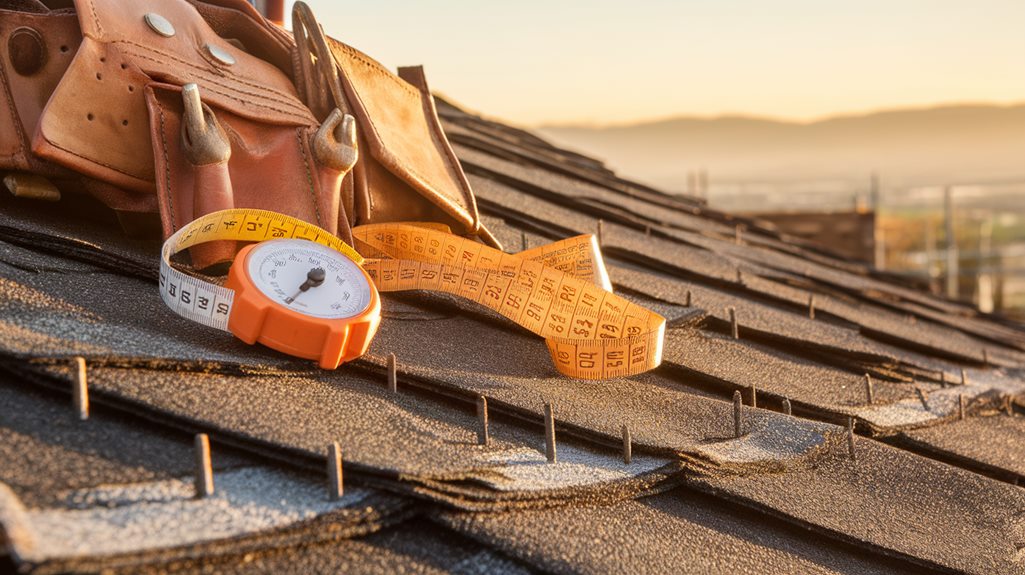
Since 2010, roofing license validation in and around Walnut Creek has evolved markedly with the introduction of digital verification systems. You can now verify your contractor's credentials instantly through the California State License Board's online portal, which updates daily with current license statuses, bonds, and insurance information.
When you're checking a roofer's license, you'll want to confirm they've maintained continuous validation since 2010 or their initial licensing date. This history demonstrates their commitment to legal compliance and professional standards. You'll find that reputable Walnut Creek contractors display their license numbers prominently and encourage verification.
The digital system also lets you track any disciplinary actions or complaints filed since 2010. You're able to see if your contractor has faced suspension, revocation, or other regulatory issues. Don't forget to cross-reference their workers' compensation insurance status, which the system tracks historically. If you notice gaps in their license validation or insurance coverage, that's a red flag. You should also verify that they've maintained their bond requirements, which have increased several times since 2010 to better protect homeowners.
Check Online Portfolio Photos
Beyond verifying licenses, examining a roofing contractor's online portfolio photos provides valuable insight into their workmanship. You'll want to carefully review their project galleries, before and after photos, and documented repair work to assess their capabilities and attention to detail. By studying these visual examples, you can determine if they've handled roofing issues similar to yours in the Walnut Creek area.
When reviewing a contractor's online portfolio, focus on these key elements:
- Image quality and clarity – Clear, well-lit photos taken from multiple angles demonstrate professional documentation and transparency in their work
- Project diversity – Look for various roofing styles, materials, and repair types to confirm they're experienced with your specific needs
- Local examples – Search for projects completed in Walnut Creek or nearby communities to validate their familiarity with regional conditions
- Detail shots – Close-up photos of flashing, valleys, and ridge vents show their technical expertise and commitment to proper installation
Don't hesitate to ask for additional photos or references if you can't find enough examples in their online portfolio. A reputable contractor will gladly provide more evidence of their successful projects.
Compare Three Written Estimates

Prior to signing any roofing contract, you'll need to obtain and compare at least three detailed written estimates from different contractors in Walnut Creek. Each estimate should include itemized costs for materials, labor, permits, and potential repairs to underlying structures. Make sure contractors specify the exact roofing materials they'll use, including brands and warranty information.
Look for estimates that break down the project timeline, payment schedule, and cleanup procedures. Don't automatically choose the lowest bid – instead, evaluate what each contractor includes in their range of work. A higher estimate might actually offer better value if it includes superior materials or more inclusive services.
Pay attention to how each estimate addresses potential complications like rotted decking or ventilation issues. The contractors should clearly state their policies for handling unexpected problems during the repair process. Also, verify that each estimate includes proper licensing, insurance coverage, and local permit costs. If any estimate seems vague or missing key details, request clarification in writing before proceeding. Keep these documents for your records and use them as reference points when negotiating your final contract.
Unlicensed Door-to-Door Roofing Solicitors
Be extremely cautious of roofing contractors who show up at your door uninvited, especially after storms or severe weather. These door-to-door solicitors often prey on homeowners who've experienced recent roof damage, pressuring them into making quick decisions with high-pressure sales tactics and "today only" deals.
In Walnut Creek, legitimate roofing contractors typically don't solicit business door-to-door. If someone knocks on your door offering roofing services, protect yourself by following these essential steps:
- Don't sign any contracts or make payments on the spot, regardless of how urgent they claim the repairs are
- Ask for their California contractor's license number and verify it through the Contractors State License Board website
- Request their local business address and check if they're registered with the Walnut Creek Chamber of Commerce
- Call your insurance company first to have them assess any storm damage before agreeing to repairs
Pine Crest Roof Restoration
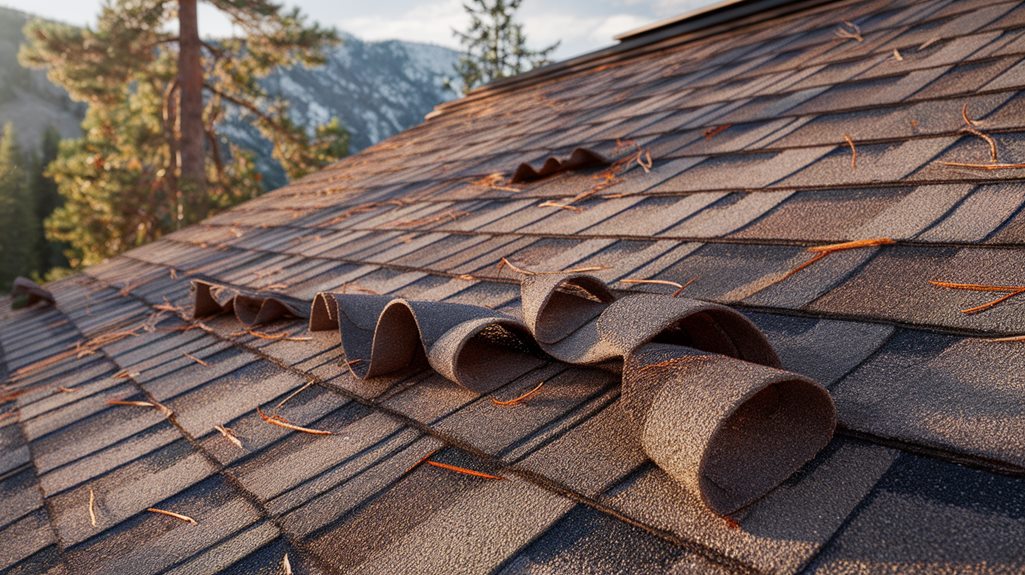
Pine Crest homeowners rely on professional roof restoration to maintain their properties' value and structural integrity in Walnut Creek's varied climate. If you're a Pine Crest resident, you'll need to address common roofing issues like deteriorating shingles, moisture damage, and compromised flashing before they escalate into major problems.
You'll find that Pine Crest's aging roofs often require specialized attention due to the neighborhood's unique architectural styles and the original construction materials used in the 1970s and 1980s. Your roof might show signs of wear through curled shingles, missing granules, or water stains on your ceiling. Don't wait until these issues worsen – schedule an inspection immediately.
When you're ready for restoration, you'll need to choose between partial repairs and complete replacement. Your decision should factor in your roof's age, extent of damage, and long-term cost benefits. Consider upgrading to modern materials that offer better protection against UV rays and moisture while maintaining Pine Crest's distinctive aesthetic. Remember to check your home's warranty and homeowners' association guidelines before proceeding with any restoration work, as specific materials and colors may be required to maintain neighborhood consistency.
Timely Leak Detection Saved Thousands
Regular inspections in Walnut Creek have proven their worth, with local homeowners saving substantial amounts through early leak detection. When you detect roof leaks early, you'll prevent extensive water damage that could otherwise cost thousands in repairs. Your vigilance in spotting potential issues can make the difference between a minor fix and a major renovation.
Here's how timely leak detection saves you money in Walnut Creek:
- Water stains on your ceiling caught early might cost $300 to repair, while waiting could lead to structural damage exceeding $10,000
- Addressing minor flashing issues promptly typically runs $500, compared to $5,000+ for extensive water damage behind walls
- Fixing isolated shingle damage costs around $400, but neglecting it can result in deck rot requiring $8,000+ in repairs
- Tackling minor gutter issues costs $200, while overflow damage to your foundation could exceed $15,000
You'll find that investing in biannual roof inspections, especially before and after Walnut Creek's rainy season, helps identify potential leaks before they become serious problems. Professional inspectors can spot subtle signs that aren't visible to untrained eyes, ensuring you catch issues at their earliest stages.
Skyline Drive Roof Maintenance
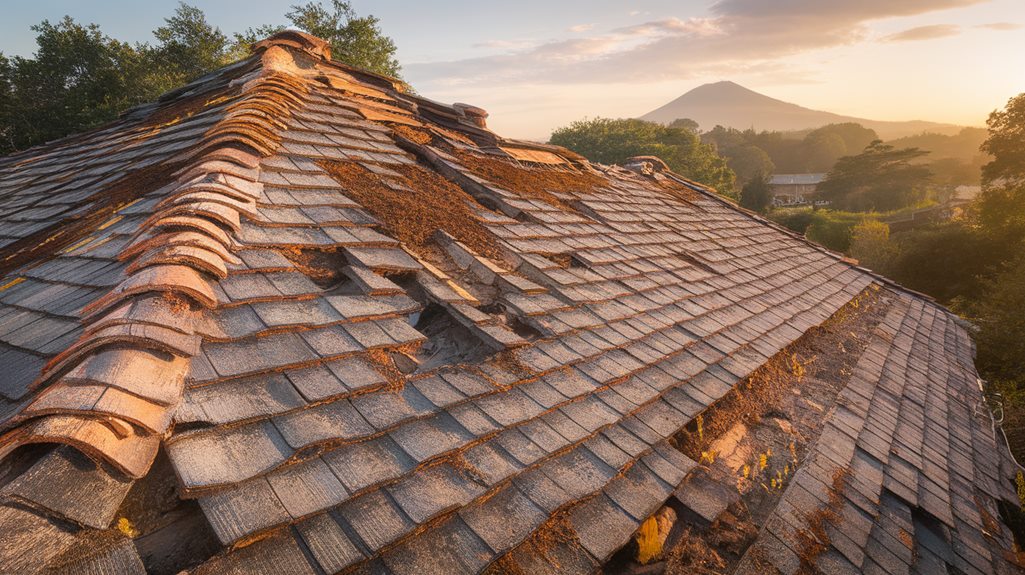
Longevity characterizes the well-maintained roofs along Skyline Drive, where homeowners have mastered the art of preservation in Walnut Creek's varied climate. If you've noticed how these homes maintain their pristine appearance, it's because residents follow a strict maintenance schedule that's proven effective against local weather challenges.
You'll need to inspect your roof's condition every spring and fall, focusing on the areas where leaves collect near valleys and gutters. Clear debris regularly, especially after strong winds sweep through the neighborhood. Don't forget to check your attic for signs of moisture or daylight peeking through, as these indicate potential trouble spots.
Your roof's shingles require particular attention – look for curling, cracking, or missing pieces, especially after storms. If you spot any issues, don't delay addressing them. Small problems can quickly escalate into major repairs if left unchecked. You'll also want to guarantee proper ventilation through your soffit vents and ridge caps, as adequate airflow prevents moisture buildup and extends your roof's lifespan. Consider scheduling professional inspections every two years to catch problems you might miss during routine maintenance.
Roofing Repairs Prevent Catastrophic Failures
When small roofing issues go unaddressed, they can spiral into devastating structural failures that'll cost you thousands in repairs. A minor leak or loose shingle might seem insignificant today, but these problems quickly compound, leading to rotted decking, compromised insulation, and weakened structural supports. You'll want to catch these issues early to prevent catastrophic damage to your Walnut Creek home.
Regular inspections and timely repairs help you avoid these major failures. Here's what can happen if you ignore warning signs:
- Water infiltration spreads beyond the initial leak point, causing widespread mold growth and wood rot that'll compromise your roof's structural integrity
- Damaged or missing shingles leave your roof deck exposed to moisture, leading to warping and deterioration that'll require complete deck replacement
- Clogged gutters force water to back up under shingles, creating ice dams in winter that'll tear away your roof's protective layers
- Cracked flashing around chimneys and vents allows constant water seepage that'll destroy your attic insulation and ceiling drywall
Don't wait until you're facing a full roof collapse – address repairs promptly to protect your home's structure and your wallet.
Annual Roof Safety Inspection
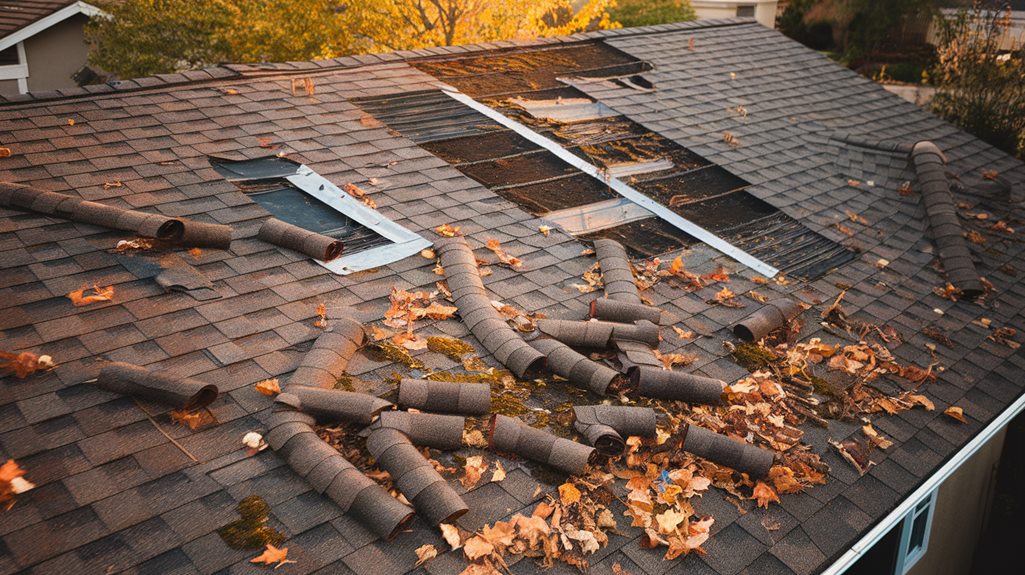
A thorough examination of your Walnut Creek home's roof should take place once a year to catch potential issues before they escalate into major problems. Schedule your inspection during spring or fall when weather conditions are favorable and visibility is at its best. You'll want to examine every aspect of your roof, from shingles to flashing to gutters.
During the inspection, look for cracked, curled, or missing shingles, which can lead to water damage. Check your roof's valleys and make sure there's no debris buildup that could hinder proper drainage. Don't forget to examine the flashing around chimneys, vents, and skylights for signs of deterioration or separation.
Inside your home, inspect your attic for water stains, mold growth, or daylight showing through the roof boards. These indicators suggest your roof may have existing leaks or ventilation issues. You'll also need to verify that your gutters are securely attached and functioning correctly.
If you're not comfortable performing these checks yourself, hire a licensed Walnut Creek roofing contractor. They'll provide a detailed assessment of your roof's condition and can identify problems that aren't visible to untrained eyes.
Schedule Free Inspection Today
Professional Walnut Creek roofing companies regularly offer complimentary roof inspections to homeowners in the area. You'll find it's easy to schedule your free inspection by calling a local contractor or submitting an online request form. Most companies respond within 24 hours to set up a convenient appointment time that works with your schedule.
During your free inspection, an experienced roofer will thoroughly examine your roof's condition and document any issues they discover. You'll receive a detailed report outlining their findings, along with recommendations for necessary repairs and a cost estimate. This valuable service helps you make informed decisions about your roof's maintenance needs without any obligation.
To prepare for your free roof inspection, follow these important steps:
- Clear your driveway to provide easy access for the inspector
- Remove any items blocking access to your attic space
- Trim back tree branches that might obstruct roof visibility
- Gather documentation of previous roof repairs or warranties
Don't wait until you notice obvious damage to schedule your inspection. Regular roof assessments can help identify potential problems early, saving you money on costly repairs down the road.
Longer Roof Life Guaranteed
Regular inspections are just the first step toward maximizing your roof's lifespan. When you partner with our Walnut Creek roofing experts, you'll receive a thorough maintenance program that extends your roof's durability by 25-40%. Our professional team identifies potential issues before they become costly problems, saving you thousands in future repairs.
We'll protect your investment by implementing proven maintenance strategies, including cleaning gutters, removing debris, replacing damaged shingles, and sealing vulnerable areas. You'll benefit from our advanced moisture detection system that spots hidden water damage before it compromises your roof's structural integrity.
Our guaranteed roof life extension program includes twice-yearly inspections, documented maintenance records, and immediate repairs when needed. You'll receive detailed reports after each visit, showing exactly what we've done to protect your roof. We're so confident in our ability to extend your roof's life that we offer a money-back guarantee if you experience any issues between scheduled maintenance visits.
Don't wait until minor problems become major expenses. With our proactive maintenance approach, you'll enjoy peace of mind knowing your roof is protected by Walnut Creek's most trusted roofing professionals.
Seasonal Roof Repair Timing
Smart timing of roof repairs in Walnut Creek can save you both money and hassle throughout the year. The Mediterranean climate in this Bay Area city creates distinct seasonal windows that are ideal for roof maintenance and repairs. You'll want to plan your repairs strategically to ensure the best outcomes and most efficient use of resources.
Consider these ideal times for different types of roof repairs in Walnut Creek:
- Spring (March-May): Perfect for thorough inspections and addressing winter damage, as temperatures are mild and rain begins to taper off. You'll have ideal conditions for detecting leaks and water damage.
- Summer (June-August): Best for major repairs and replacements due to consistently dry weather. Roofing materials will properly seal and adhere in the warm temperatures.
- Early Fall (September-October): Great for preventive maintenance before the rainy season. You'll want to clean gutters, replace damaged shingles, and seal any potential leak points.
- Winter (November-February): Emergency repairs only, as wet conditions make it challenging and potentially hazardous for roofers to work. You'll pay premium rates during this season.
Walnut Creek Building Department
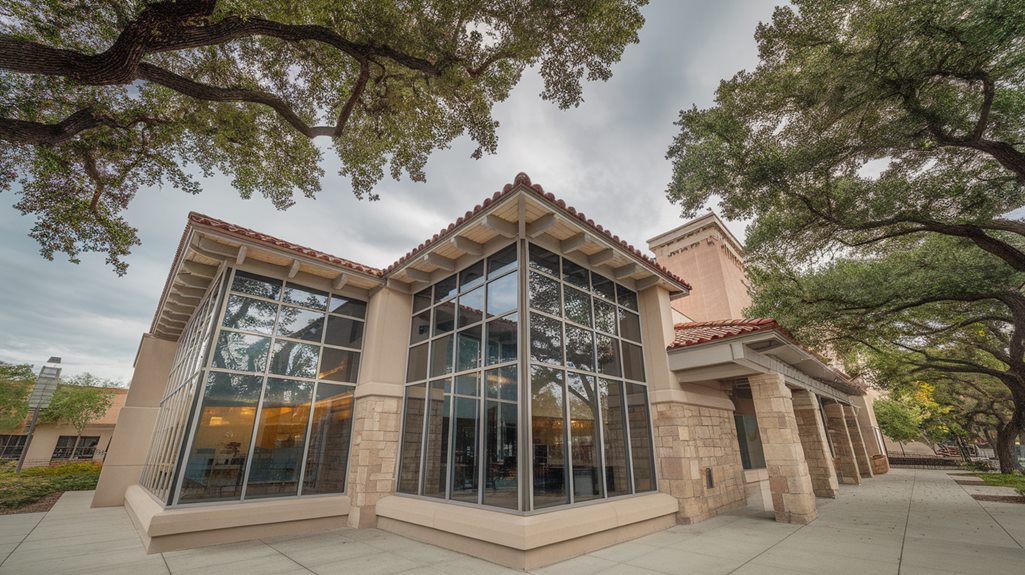
Before scheduling any roof repairs in Walnut Creek, you'll need to coordinate with the city's Building Department, located at 1666 N. Main Street. The department requires permits for most roofing projects, especially those involving structural changes or complete re-roofing work.
You'll find permit applications on the city's website or at the department's office. For minor repairs under $1,000, you won't typically need a permit, but it's best to confirm with the department. When applying, you'll need to submit detailed project plans, contractor information, and pay the required fees, which vary based on your project's scope.
The department typically processes permits within 5-10 business days, though complex projects may take longer. Your contractor must schedule inspections at specific points during the repair process, including a final inspection upon completion. If you're working in a historic district or your home is part of an HOA, you'll need additional approvals before proceeding. Remember to keep all permit documentation and inspection records, as you'll need them if you sell your home in the future.
Conclusion
Don't let your roof become a ticking time bomb of expenses. You'll save thousands by addressing warning signs early, from subtle leaks to wind-torn shingles. Schedule your free inspection with Walnut Creek's trusted roofing experts before minor issues cascade into major structural damage. When you protect your home's crown today, you're investing in your property's future and your family's safety.

